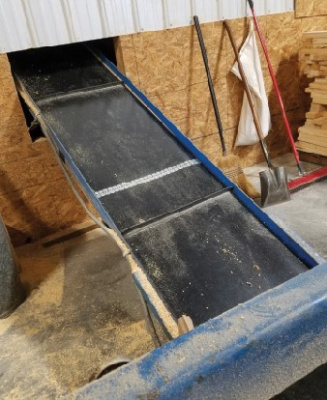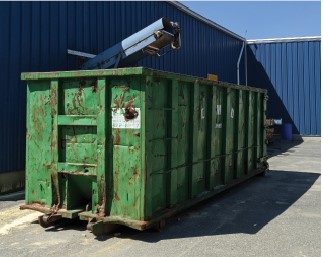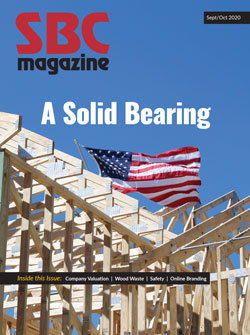It Pays to Get Carried Away
It Pays to Get Carried Away
“We’ve had the conveyor system since 2008. At the time, I figured it was going to eliminate an hour of forklift time a day,” says Mike Boulet, general manager at Mainely Trusses in Fairfield, Maine. Before the conveyor was installed, the waste would come off the component and floor truss web saw onto an inclined conveyor and then into a self-dumping hopper that was forklifted for disposal multiple times a day. “We wanted to be more efficient with how we were handling our wood waste coming off the end of the saw.”

The conveyor system was designed to take the sawdust and wood waste from the component and floor truss web saw, as that saw created the most waste. “It’s a custom conveyor, not off the shelf. We had it made to our specs because it’s at a right angle at the saw,” explains Mike. “We paid around $20,000 to have it installed and wired.”
Installing the conveyor made the wood waste collection process relatively simple. “We have two dust collectors in our plant for our linear, floor truss web, and radial arm saw, so everything for us is pretty mixed in,” says Mike. “The conveyor collects the sawdust and wood waste and dumps it into a 40 yard roll-off hopper in the yard and when it gets full, it’s hauled off to a local recycler. The local recycler owns the truck and the cans, and we just pay them to haul it. We do get paid a small amount for the product; it’s negligible, but we do receive a little based on the tonnage. For the most part it’s virtually no labor because we aren’t grinding it or doing anything to change its shape, it’s just coming off the saws and going straight onto the conveyor and then into the roll-off hopper.”
Additionally, the conveyor system is low-maintenance. “We change the fluids in the gear box annually, and the grip belt on it needs to be replaced every two to three years or so,” Mike explains. “The last belt I bought was just over 800 dollars and it’s about 60 feet long. There are some flights on it so the material doesn’t keep rolling backwards and sometimes those get jammed up and need to be replaced, but overall the maintenance is pretty light.”

Mike has considered other alternatives over the years for wood waste disposal, but he is content knowing it is not going into a landfill. “Honestly, I just like knowing our wood waste is being recycled rather than going into the ground. What we get back doesn’t cover the trucking costs of the product, but it’s better than paying a solid based landfill to dispose of it,” shares Mike. “I’m sure the recycler is able to reuse the product in different products like bio mass or pellets or other things that could go to other factories that are using solid wood waste for heating or operations and things like that.”
“In the early years of the business, in the 90s, we had a local paper mill where we could just drop off the wood waste and it went directly into their operations,” Mike recalls, “but they went out of business, so ever since, we’ve been working with recyclers, and we’ve used three different recyclers within 90 miles. We’ve been fortunate we’ve been able to do this for many years, and we’ve never had to pay to dispose of it to a landfill.”
For component manufacturers (CMs) interested in setting up a custom conveyor, Mike recommends reaching out to a local machine shop. “We went to a local shop that made custom machinery for different types of manufacturing operations. I had dealt with them over the years with other projects that I was not able to get ‘off the shelf,’” he explains.
Mainely Trusses is just another example of how CMs dispose of their wood waste. For another approach, read the June/July 2020 article that explores how Truss Tech Industries, Inc. uses a grinder system to sell all their wood waste as sawdust.
We will continue to look at how other CMs are reusing or disposing of their sawdust in future articles. If you have a unique disposal process that you think other CMs would benefit from learning about, please contact SBCA Staff so your story can be shared in future issues of SBC Magazine.

